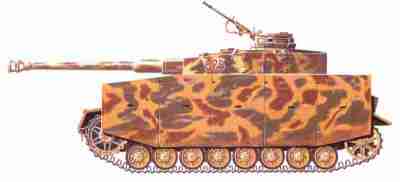Panzerkampfwagen IV, SdKfz 161


The PzKpfw IV, produced in larger numbers and more versions than any other German tank
between 1933-45, was certainly the workhorse of the Panzer Divisions. It was designed by
Krupp as the main infantry support/assault tank. However, since it was bigger it could be
equipped with more powerful guns and thicker armor. Eventually the PzKpfw IV became, with
the Panther, the main battle tank of the German Army.
The PzKpfw IV, like the
PzKpfw III,
had a five-man crew and was at first intended to equip
one out of the four companies in each Panzer battalion, the other three with
PzKpfw IIIs.
However, wartime losses and attrition quickly decreased the battalions to three companies
-- one with PzKpfw IVs and two with
PzKpfw IIIs.
When the
Panther
was available the ideal
combination became two battalions each of PzKpfw IVs and
Vs,
each of four companies. This, however, was rarely achieved in reality.
The 35 original PzKpfw IV Ausf As were pre-production vehicles with only mild steel armor.
It had eight roadwheels, sprung in pairs, each side, and four return rollers. This system
was kept almost throughout the tank's career. The Ausf B had proper welded armor, thicker
frontal armor, and a gearbox with six-speed instead of five to improve cross-country
performance. Forty-two Ausf Bs were built, and before the invasion of Poland, 134 Ausf Cs,
with further detail refinements, were also produced.
Production of the Ausf D/E began in the same month (229 and 223 built respectively). The
armor was upgraded, the gun mantlet reshaped, and better vision blocks installed for the
driver. The first 462 Ausf Fs had slightly wider tracks to improve the ground pressure and
give better power-to-weight ration. All of the production models so far mounted the short
75mm KwK L/24 to support infantry. Then production was postponed for a month so that
changes could be made (particularly to the ammunition stowage compartments because of the
longer rounds) to accommodate the hard-hitting high-velocity L/43 cannon. The first Ausf Fs
with the short gun were renamed Ausf F1, the following 175 with the long gun F2. A
single-baffle muzzle brake was installed to the end of the barrel to reduce the recoil
forces; or else the breech would fly into the rear of the turret. This improvement was the
critical turning point for the PzKpfw IV, which could now engage the T-34 at reasonable
ranges. Many earlier models were then retrofitted with the L/43.
A double-baffle muzzle brake was installed on the 3,774 Ausf H and 1,748 Ausf J so that the
even more powerful 75mm KwK L/48 could be used. Other changes included thicker armor, the
addition of spaced armor skirts (Schürzen) to help counter hollow-charge projectiles, and
easier production to facilitate manufacture. In the Ausf J power traverse was dispensed
with for more room for fuel and ammunition stowage (a bad trade in the eyes of most
crewmen), the number of return rollers was decreased from four to three, and the number of
pistol ports was reduced. A few Ausf Hs served as command tanks, but unlike the PzKpfw
IIIs they kept their full armament.
In spite of its high, boxy appearance with many shot traps, the PzKpfw IV was the only
German tank to remain in production throughout the war, a clear testimony to what was
definitely a sound design for its time. Its hull and chassis were also used by assault
guns and self-propelled artillery pieces. It had a spacious interior and was generally
welcomed by its crews because of its reliability, even though its armor and armament were
inferior to the
Panther and
Tiger.
Back to German Tanks Page
Back to Heer Page
Back to Homepage